London Research Report, Day 1, Part 2
Oysters at Bentley's
If you are just jumping into this particular narrative, please note that the first item consumed in my first few hours in London was absinthe at the Café Royal. Even since writing that last entry, I have learned so much more about the Café, absinthe, and Crowley himself, that both the Café and absinthe will be subjects to which I shall be returning in the future. However, that delightful pick-me-up was simply the aperitif before the my first dinner at a Crowley-frequented establishment; in this case, Bentley’s.
Crowley took up residence in London multiple times during his lifespan; sometimes just staying a day or two while hopping between Paris and his home in Scotland, Boleskine House. Some of his longest stints in London seemed to be in the 1930s and 40s, leading up to and during World War II. From his diaries, he specifically cited dining at Bentleys almost a dozen times (which makes me believe he frequented it far more often than that). Bentley’s Oyster Bar & Grill is in the same Soho neighborhood as the Café Royal and Veeraswamy, both Crowley haunts. Opened in 1916, Bentley’s was one of the stalwarts where Crowley dined upon oysters, but Bentley’s was — and still is — more than just an oyster bar. From his December 1, 1941 entry he exclaims in his diaries, “posh tiffin at Bentley’s.” Posh being “upscale” or “upper crust,” and tiffin as derived from the English slang, “tiffing,” which originally meant to take a little drink, but evolved in South East Asia to mean a light meal. Later, the word tiffin was applied to specially-designed tiered lunchboxes, more commonly known and used in India. For me, this was not just a light meal, but the full blown experience, starting at the entrance by grasping heavy brass door handles.
Foregoing the seating area with booths and tables, I asked to sit at the Oyster Bar…
If you didn’t know this about me already, I wrote a book on oysters, so I take their consumption very, very seriously — as does Crowley. In his Confessions, he admits that he “ultimately learnt that [he] could make [himself] actually drunk on a half a dozen oysters chewed in the manner of the yogis.” What does that mean? It is more than emphasizing a sattvic diet of focusing on whole grains and fresh ingredients. It is to give whatever is being consumed your full attention; reserving part of your awareness towards the concentration of chewing and swallowing. Most people slurp oysters with barely chomp and allow them to slide down their throat, perhaps in fear of experiencing the variables in texture and taste that an oyster can provide. Oysters should be chewed to release their full range of flavors — from briny to cucumber, coppery to sweet, umami to buttery, creamy to nutty, etc.
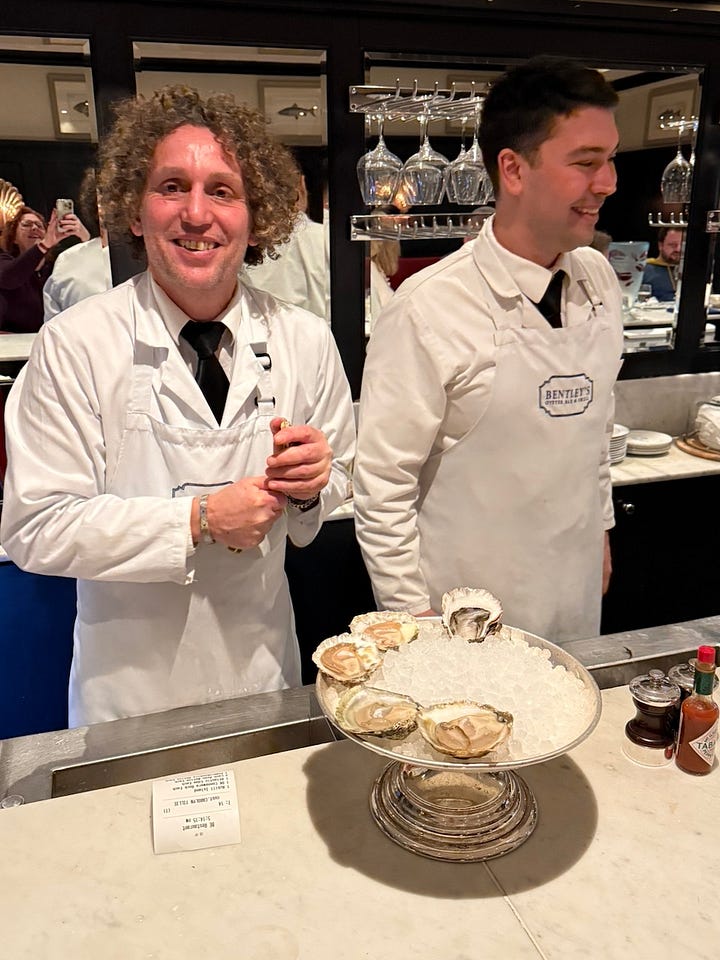
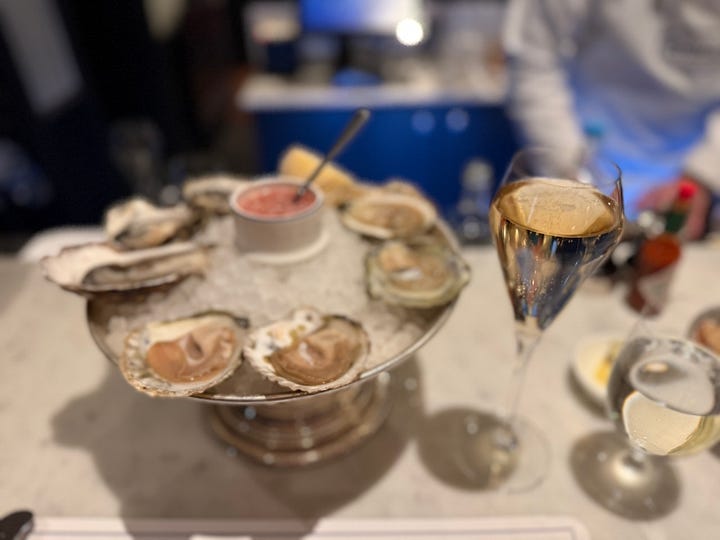
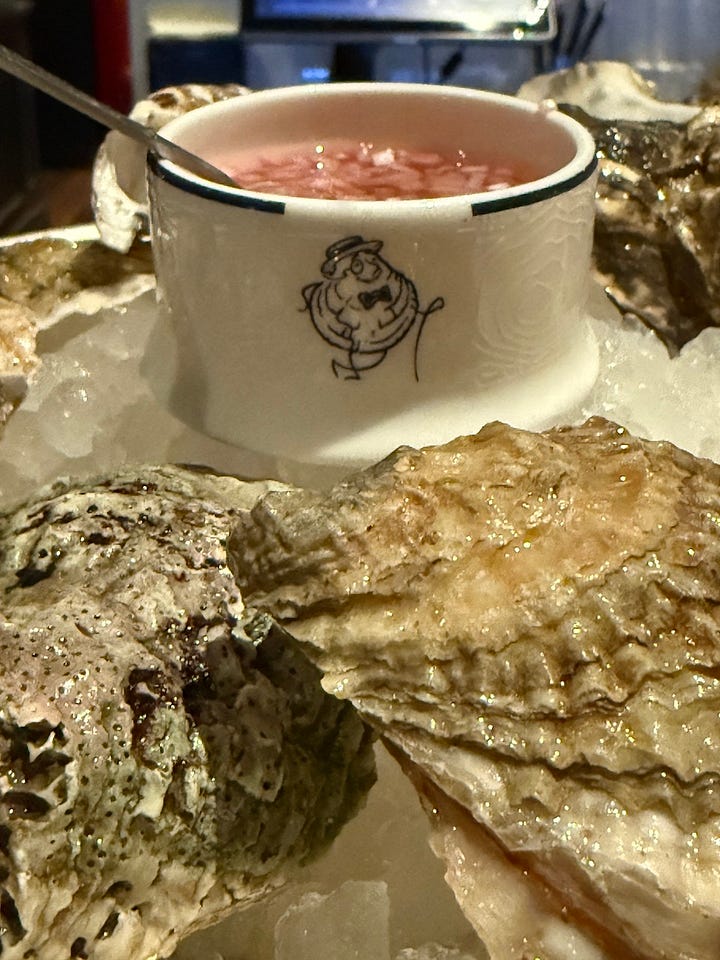
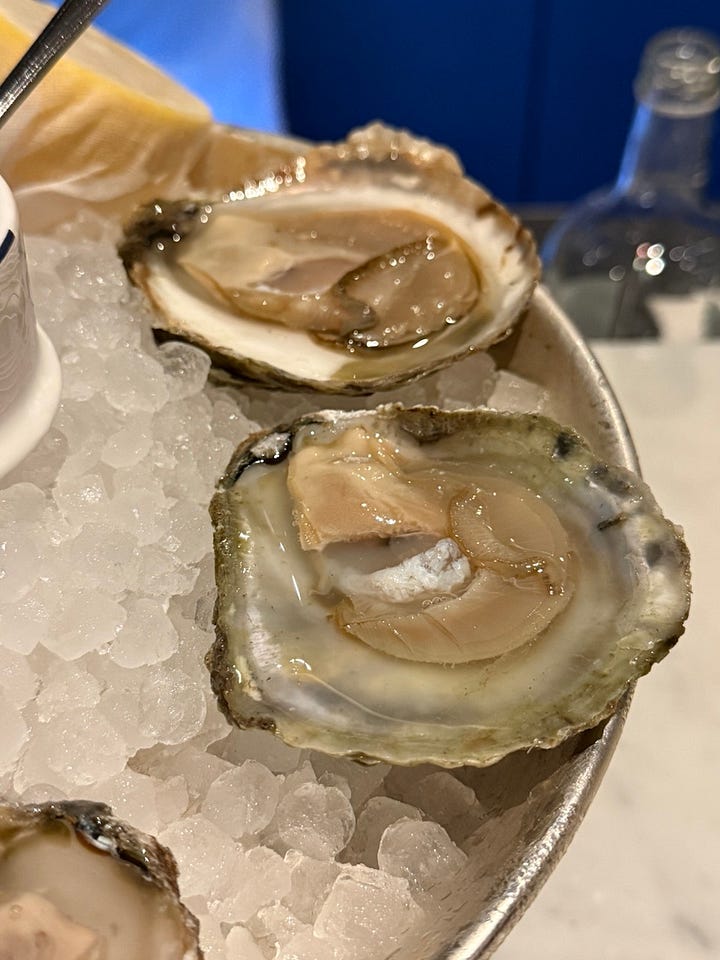
Sitting at the bar, downstairs, I was extremely lucky to have two very amiable servers, Lilo and Frederico, who displayed an obvious and genuine camaraderie for each other, the food with which they worked, as well as joy in interacting with customers. When in Europe and England specifically, I always look for those oysters that are scarce in the United States, “Natives” which are Ostrea edulis; bigger, flatter, with more flavor (to me), than Crassostrea gigas — or the Pacific oyster — which is the most prevalent oyster world-wide. That evening, I had two from Loch Ryan, the Scottish lowlands, two Atlantic Edge from Pembrokesure, and another three various gigas from Ireland and Wales, paired with a refreshing Paul Dethune Ambonnay Grand Cru Champagne. In the pictures, you can see my oysters were served with a mignonette (light, red wine vinegar with chopped shallots), and nearby where the boys were shucking is a bottle of Tabasco® sauce. Being an absolute purist, I will always first taste an oyster unadorned, in its own liquor. Then, if I feel it would benefit from a slight alteration, a squeeze of lemon juice should suffice, but nothing more. I don’t understand those who drown their oysters in sauces (especially spicy ones!) and flavorings that mask the individual and distinctive flavors of the beloved bivalves.
To start the meal, was a beef tartare made with Irish Hereford beef, unctuous oyster cream, and crispy shallots. Reputedly having roots from Central Asia (particularly the nomadic Tartars, from which its name is derived), steak tartare — or beef tartare as it is commonly known — is finely chopped raw beef that is more closely associated with the French for the dish’s popularity grew in Parisian bistros of the 20th century. Across the channel, we have the French chefs to thank for their additions of capers, onions or shallots, Dijon mustard and raw egg to bind it all together with the raw beef. Serving the tartare with thin, toasted bread is simply a mechanism in order to aid the diner in lifting all that bold, savory concoction to one’s mouth, but also to provide a contrasting crunch to an otherwise mushy mouthfeel. While I am confident that Crowley would have dined on a tartare or two in his lifespan, I’m not sure he would have had one with an oyster-essenced cream alongside, but this proved a welcome and complementary addition.
For main course, I was thrilled to see their menu wasn’t entirely mired in twee 21st century concoctions and modernistic degustations, but still contained some classic, old school dishes from the early 20th century, like this Lobster Thermidor.
There is quite a bit of folklore and even more variations of recipes behind the Lobster Thermidor. To say it is decadent is an understatement. It is reputed to have been inspired by the 1891, Victorien Sardou-written play, Thermidor, with multiple French chefs (Escoffier and Mourier the leading contenders) supposedly the dish’s creator. Recipe-wise, the lobster is halved (yes, while still alive) and the tail meat removed. Placing the tail meat back into its shell, it is briefly baked for a few minutes to pre-cook the meat. In the meantime, a sauce is made and this is where the historical discrepancies begin to occur. Some recipes involve the creation of a béchamel with white wine and herbs. Others insist it be a Cognac-infused cheese sauce. There are those who add mushrooms and even others who cheat, using crème fraîche instead of a master sauce. I grew up with a Mother who was crazy about lobster, ordering it whenever possible on the rare occasions we dined at swanky restaurants. Being the 1970s, she could also suffice with the <gasp!> frozen T.V. dinner version made by Stouffer’s. (Rumor has it that it was quite tasty!)
But I digress…. My meal is about to close, but not without a memorable finish and there was a bit of guilt seeping in as I was enjoying such largesse while thinking about Crowley and the troubles he was having in 1942, when there were two pointed Bentley’s entries in his diaries. First, at the end of January of that year, he remarked that his “dear old waitress” at Bentley’s told him he “was looking like hell!” He was having black-outs, heavy snows were falling, there was no central heating, and all he could do was mostly sleep “with short intervals for eating” Later, in the middle of March, he was plagued by a “Miltonian” cough, diarrhea, and fevers, but finding warmth and sustenance at Bentley’s. Plus there were air raid warnings. Britain was at war and with it came rationing; not just food, but all material goods. Each person was allotted 66 coupons a year with which they could buy clothing, shoes, and handkerchiefs.

For many — and possibly Crowley (although I have yet to have confirmation) — succor was to be found at “Community Feeding Centres,” later renamed by Winston Churchill as “British Restaurants.” Set up by the Ministry of Food, these communal kitchens were established in 1940 to help feed people who had been bombed out of their homes or who had run out of ration coupons. So popular were they that by 1943, more than 2,000 British Restaurants served upwards of 600,000 meals a day. However Crowley continued to find warmth and sustenance at places like his beloved eateries for, surprisingly, ordinary restaurants were not subjected to rationing. Feeding people well was thought to keep morale up, but there were restrictions: No meals more than three courses, and the price could be no higher than five shillings (about £20 in 2025). Needless to say, I know of no restaurants serving three-course meals for £20 these days, so feel free to question my calculations on that accord.
Ah yes, on to my memorable finish. Sticking with old school options and the fact that it is prepared table side (or in my case, counter side), Frederico deftly assembled and flamed Crêpes Suzette and thus my first full day in London endeth:


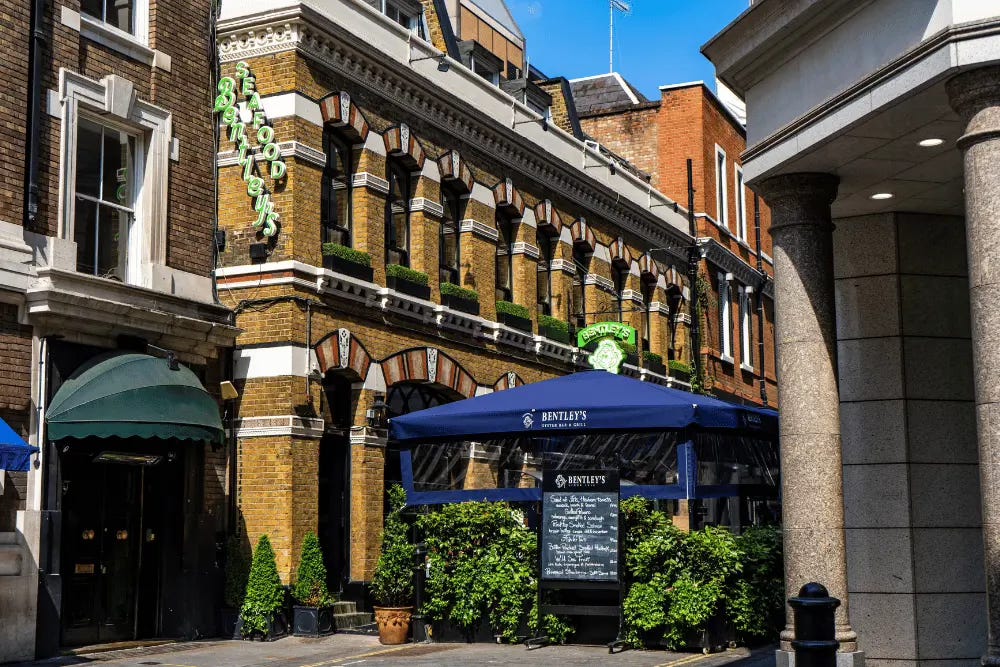

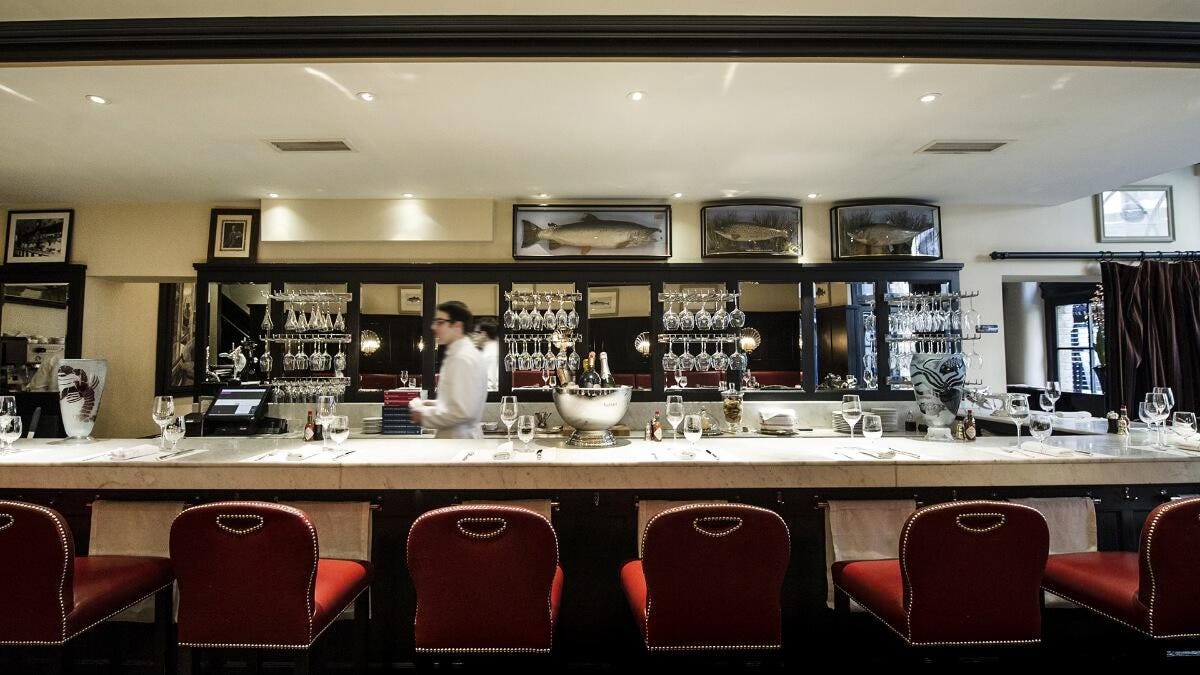
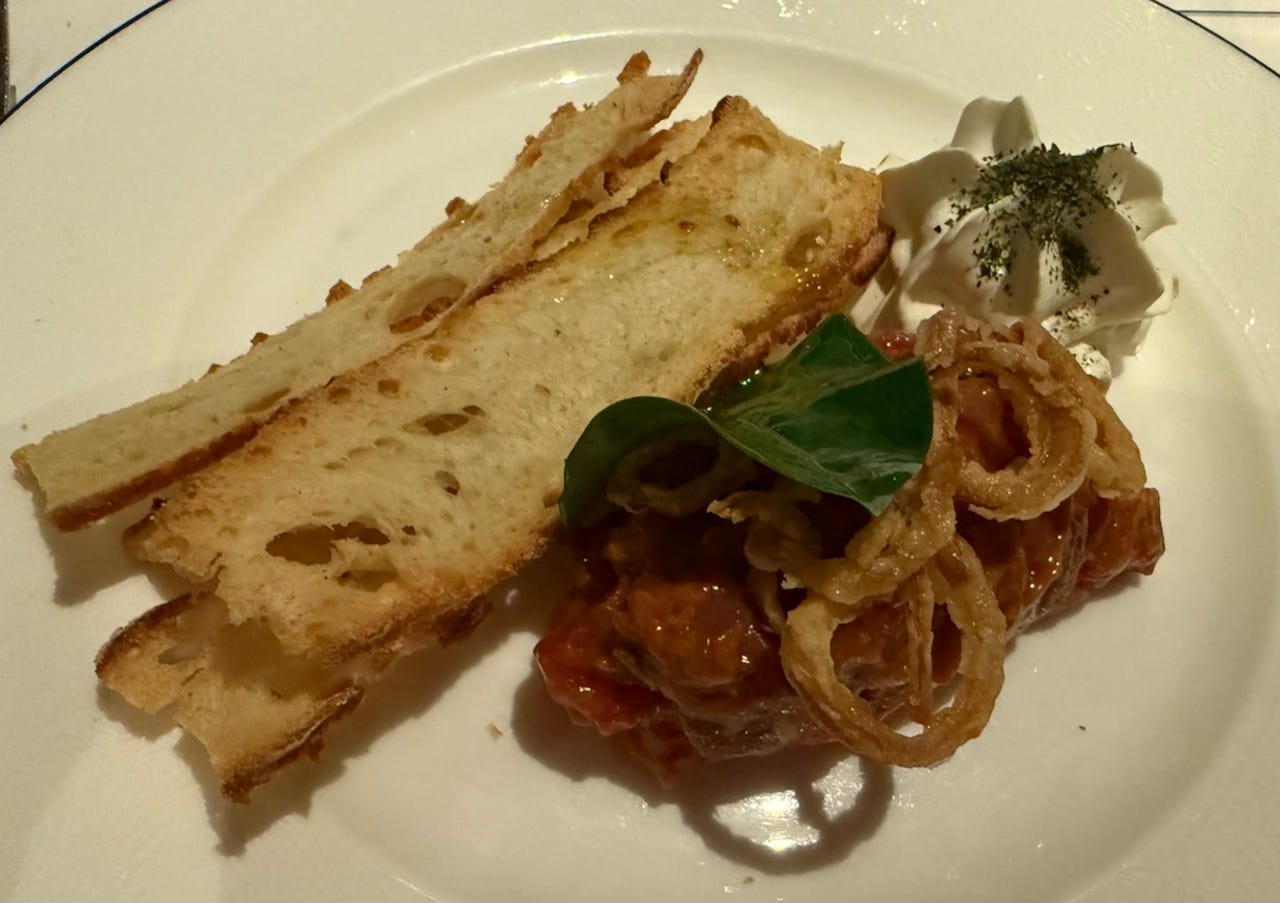
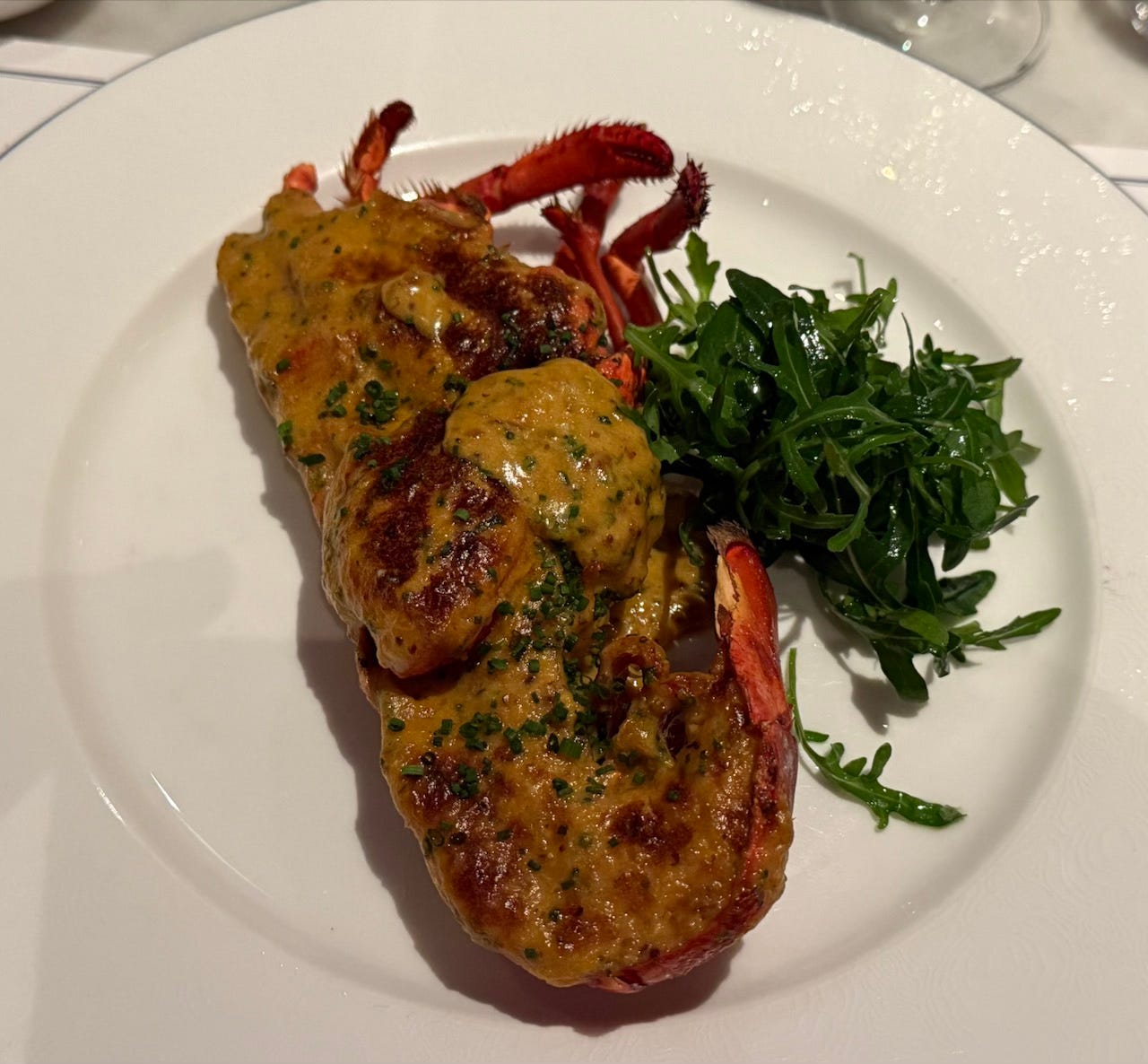
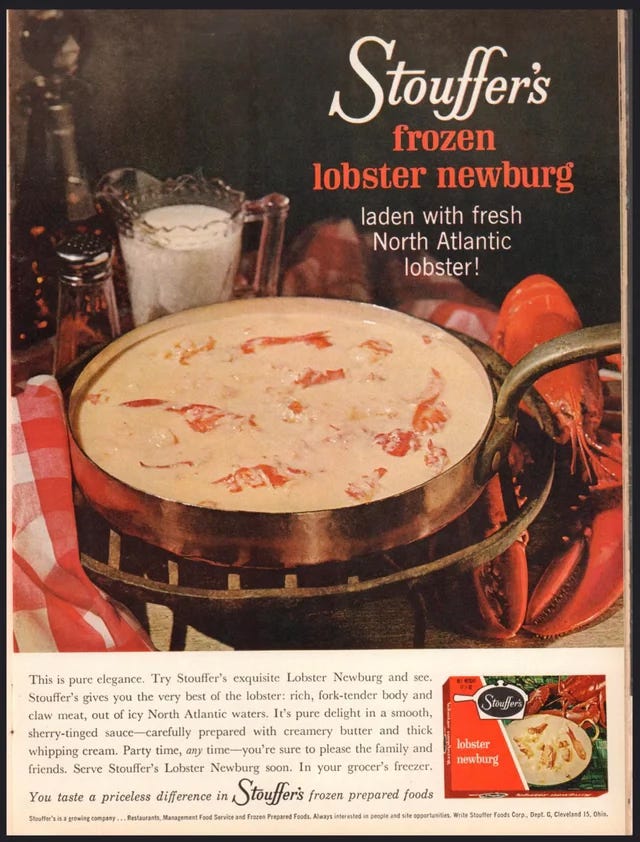
Magnificent Thank You Thank You . Now I am Hungry for oysters
Love this! Reminds me of the chilled oysters and cucumber mignonette recipe I adapted from hit NYC restaurant Via Carota for easy home cooking!
check it out:
https://thesecretingredient.substack.com/p/get-via-carota-recipe-chilled-oysters-with-cucumber-mignonette